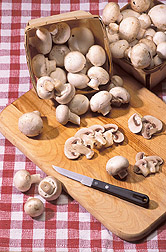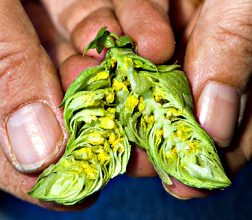| January 2009 |
Improving Food Survey MethodsInnovations in food consumption survey methods that increase the accuracy of the ongoing national food intake survey, "What We Eat in America," have been validated in a newly published study. During dietary surveys, people are asked to report which foods—and how much of those foods—they have eaten. When people answer, some may actually have consumed more or less food than they were able to recall. Researchers at the Agricultural Research Service (ARS) Food Surveys Research Group developed a computer-assisted dietary recall method called the Automated Multiple-Pass Method, or AMPM for short. The method involves a five-step interview process used to inquire about all eating occasions and all foods consumed during the previous 24-hour eating period. This study confirmed the effectiveness of the AMPM. Research findings show the method enabled the volunteers to recall what they'd eaten to within 11 percent of the actual calories they used as a sample group. Scientific contact: Alanna Moshfegh, (301) 504-0170, Food Surveys Research Group, ARS Beltsville Human Nutrition Research Center, Beltsville, Md. |
|
|
|
Study Shows Consuming Hibiscus Tea Lowers Blood PressureDrinking hibiscus tea lowered blood pressure in a group of pre-hypertensive and mildly hypertensive adults in a study funded by the Agricultural Research Service (ARS). For six weeks, about half the study group was randomly selected to drink three cups of hibiscus tea daily. The others drank a placebo beverage containing artificial hibiscus flavoring and color. The findings show that the volunteers who drank hibiscus tea had a 7.2 point drop in their systolic blood pressure, compared to a 1.3 point drop in the volunteers who drank the placebo beverage. Scientific contact: Diane L. McKay, (781) 608-7183,Jean Mayer USDA Human Nutrition Research Center on Aging, Boston, Mass. |
Increasing Calcium in Carrots and Other VegetablesResearchers funded by the Agricultural Research Service (ARS) have boosted calcium levels in carrots by inducing the carrots to express increased levels of the gene sCAX1, which enables the transport of calcium across plant cell membranes. To determine the bioavailability of the calcium in the modified carrots, 30 volunteers—15 females and 15 males of various ethnic backgrounds and in their early to late 20s—ate single meals containing regular or modified carrots, which were labeled with a stable isotope of calcium. After two weeks, the researchers found that the calcium intake of volunteers who consumed the modified carrots increased by 41 percent, compared to those who ate regular carrots. Scientific contact: Kendal Hirschi, (713) 798-7011, ARS Children's Nutrition Research Center, Houston, Tex. |
|
|
Fight Osteoporosis: Bone Up on a Quality DietFindings from a new study funded by the Agricultural Research Service (ARS) suggest vitamin C may be protective against bone loss in older men. Researchers funded by the ARS reported the findings in the October issue of the Journal of Nutrition. The researchers examined whether fruit- and vegetable-specific antioxidants such as vitamin C might decrease oxidative stress that is linked to accelerated bone loss. The researchers observed significant positive associations for total vitamin C—both dietary and supplemental—among men who never smoked. Scientific contact: Katherine Tucker, (617) 556-3351, Jean Mayer USDA Human Nutrition Research Center on Aging, Boston, Mass. |
Antioxidant Effects from Eating AlmondsEating almonds significantly decreased levels of two biomarkers for oxidative stress in a group of 27 male and female volunteers with elevated cholesterol. The study was conducted by scientists funded by the Agricultural Research Service (ARS), the Almond Board of California, and the Canada Research Chair Endowment. Treatments consisted of a "full dose" of almonds, defined as 73 grams daily (about 2.5 ounces), a "half-dose" of almonds plus a half-dose of muffins, and a full-dose of muffins as a control. The research team found that when the volunteers ate the full dose of almonds, their concentration of two biomarkers of oxidative stress—plasma malondialdehyde (MDA) and urinary isoprostanes—were significantly lowered. MDA decreased by nearly 19 percent compared to the start of the study in the full-dose almond group. Isoprostane decreased by 27 percent in both the almond groups when compared to the control period, suggesting a possible threshold effect for that biomarker. Scientific contact: Jeffrey Blumberg, (617) 556-3333, Jean Mayer USDA Human Nutrition Research Center on Aging, Boston, Mass. |
|
|
|
Database of Isoflavone Compounds in Foods UpdatedThe food composition database for the plant chemical compounds called isoflavones has been updated by Agricultural Research Service (ARS) scientists. The newly updated database provides analytical values for three individual isoflavone compounds—genistein, daidzein and glycitein—in nearly 550 foods. These are grouped under 21 separate categories, such as "Legume Products," "Baked Products" and "Baby Foods." The Isoflavone Database is one of several "Special Interest Databases" produced by NDL to provide data on bioactive compounds for selected foods. Others include the Flavonoid, Proanthocyanidin and ORAC databases. Scientific contact: David B. Haytowitz, (301) 504-0714, Nutrient Data Laboratory, ARS Beltsville Human Nutrition Research Center, Beltsville, Md. |
Vitamin D-Rich MushroomsAgricultural Research Service (ARS) scientists have teamed with Monterey Mushrooms, Inc., of Watsonville, Calif., to boost the vitamin D content of white, brown and portabella mushrooms. Thanks to UV-B light—like that in sunshine—the company's new Sun Bella line of fresh mushrooms offers at least 100 percent of the recommended intake of vitamin D in each 3-ounce serving. An estimated 40 percent of Americans don't get enough vitamin D. Scientific contact: Tara McHugh, (510) 559-5864, Processed Foods Research Unit, ARS Western Regional Research Center, Albany, Calif. |
|
|
Hops Extract May Reduce Clostridium in ChickensHops contain substances that control pathogenic bacteria in the intestines of chickens, Agricultural Research Service (ARS) scientists and cooperators have reported. The hop plant (Humulus lupulus) contains bitter acids known to be potent antimicrobials. One of these compounds, lupulone, was thought to control levels of the disease-causing agent Clostridium perfringens in chickens. In tests, researchers delivered different concentrations of lupulone via water to chickens inoculated with C. perfringens. After 22 days—the time frame associated with clostridial disease in broiler chickens—C. perfringens counts were significantly reduced in the lupulone-treated group compared to another group of chickens that did not receive the lupulone treatment. The reductions ranged from 30 to 50 percent. Based on the results of this study, the potential for lupulone as an antibiotic alternative in poultry rearing is feasible. Scientific contact: Gregory Siragusa, (706) 546-3531, ARS Poultry Microbiological Safety Research Unit, Athens, Ga. |
USDA Children's Nutrition Research Center Celebrates 30th AnniversaryOfficials with the U.S. Department of Agriculture, Baylor College of Medicine and Texas Children's Hospital celebrated 30 years of cooperative children's nutrition research in October. Officials from the organizations renewed a long-term agreement at the Children's Nutrition Research Center (CNRC) to conduct cooperative research on obesity and other issues affecting the health of children in the United States. The Agricultural Research Service (ARS)—the intramural scientific research agency of USDA—and Baylor College of Medicine manage CNRC through an agreement that has allowed the center to operate as a cooperatively run research institution. CNRC researchers have published more than 3,000 peer-reviewed scientific papers since the center's inception in 1978. Scientific contact: Dennis M. Bier, (713) 798-7022, ARS Children's Nutrition Research Center, Houston, Texas |
|










